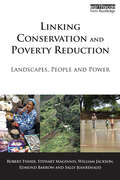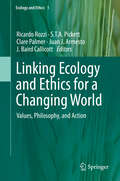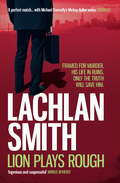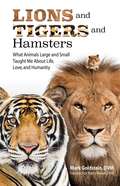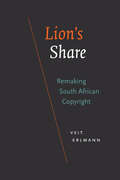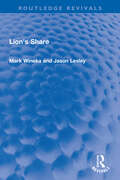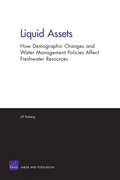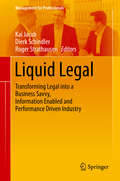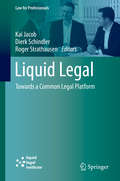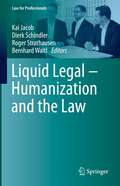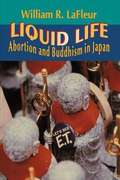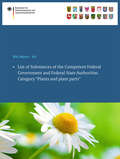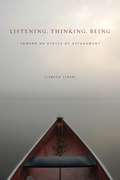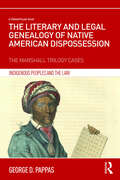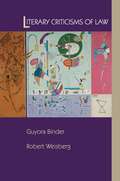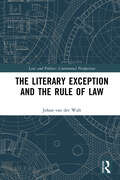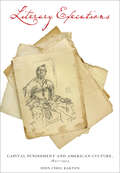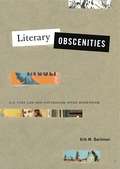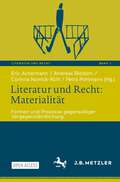- Table View
- List View
Linking Conservation and Poverty Reduction: Landscapes, People and Power
by Robert Fisher William Jackson Stewart Maginnis Edmund Barrow Sally Jeanrenaud'This book aims to inspire the conservation community not to regard poverty reduction as someone else's job but to take responsibility for it as part of ecosystem restoration. Though no solutions are perfect,the text and examples given offer encouraging and useful guidance.' Gill Shepherd, poverty and landscapes thematic leader, IUCN Forest Conservation Programme. 'This book could be the catalyst for a real paradigm shift - not just in capital cities and international conference centres, but also on the ground in locations where poor people are struggling to make a living.' Policy Matters (praise for the first edition). High levels of rural poverty in many of the world's ecosystems make it an ethical and practical imperative to find more equitable and realistic ways of achieving conservation. Livelihoods of the rural poor and options for conservation and sustainable use of biological diversity are so intimately entwined that they are better addressed through an integrated approach, irrespective of whether the primary motivation is one of development or one of conservation. This highly accessible book, a revised edition of the 2005 book Poverty and Conservation: Landscapes, People and Power, offers a grand overview of the issues and a conceptual framework for addressing poverty reduction in the context of conservation, and conservation in the context of poverty reduction. It will appeal to professionals working in the field as well as to students across the fields of conservation, development and sustainability. It looks at the rationale for addressing the links between conservation and poverty reduction, arguing that such a focus is both ethically essential and a source of opportunities. It alsoreviews experiences in dealing with people and conservation and identifies some key lessons and concepts. The book presents cases studies illustrating various approaches and a discussion of some of the issues that appear when implementing combined conservation and poverty reduction. The book emphasizes the importance of multiple spatial scales and negotiating trade-offs between scales. It also tackles the complex issue of institutional landscapes and the way in which changes at various institutional levels can lead to different and often more positive outcomes. The Final part summarizes some of the main features of the authors' integrated approach and identifies some of the challenges involved in efforts to combine conservation and poverty reduction. Published with IUCN - The World Conservation Union.
Linking Ecology and Ethics for a Changing World
by Ricardo Rozzi S. T. A. Pickett Clare Palmer Juan J. Armesto J. Baird CallicottTo comprehensively address the complexities of current socio-ecological problems involved in global environmental change, it is indispiseble to achieve an integration of ecological understanding and ethical values. Contemporary science proposes an inclusive ecosystem concept that recognizes humans as components. Contemporary environmental ethics includes eco-social justice and the realization that as important as biodiversity is cultural diversity, inter-cultural, inter-institutional, and international collaboration requiring a novel approach known as biocultural conservation. Right action in confronting the challenges of the 21st century requires science and ethics to be seamlessly integrated. This book resulted from the 14th Cary Conference that brought together leading scholars and practitioners in ecology and environmental philosophy to discuss core terminologies, methods, questions, and practical frameworks for long-term socio-ecological research, education, and decision making.
Linking Global Trade and Human Rights
by Daniel Drache Lesley A. JacobsDuring the global economic crisis of 2008, countries around the world used national policy spaces to respond to the economic crisis in ways that shed new light on the possibilities for linkages between international trade and human rights. This book introduces the idea of policy space as an innovative way to reframe recent developments in global governance. It brings together a wide-ranging group of leading experts in international law, trade, human rights, political economy, international relations, and public policy who have been asked to reflect on this important development in globalization. Their multidisciplinary contributions provide explanations for why the global landscape for national policy space has changed, clearly illustrate instances of this change, and project the future paths for policy development in social and economic policy spaces, especially with reference to linkages between international trade and human rights in countries from the Global North as well as Brazil, China, and India.
Lion Plays Rough (Leo Maxwell)
by Lachlan SmithLeo Maxwell is a criminal defense attorney on the lookout for the big case that will make his reputation. When a mysterious woman hires him to defend her brother on a murder charge he thinks he may have found it. But things are not what they seem - he's been set up to become the number one enemy of both a vicious gangland boss and the police.Hounded by threats from all sides, he finds himself with a price on his head and framed for murder.Leo's a marked man unless he can somehow turn the tables. But as the bodies pile up and Leo closes in on the truth, he discovers that it is far more sinister than he imagined and forces him question everything that he holds dear...
Lions and Tigers and Hamsters: What Animals Large and Small Taught Me About Life, Love, and Humanity
by Dr. Mark GoldsteinFrom the time Dr. Mark Goldstein was a little boy—even before he had his first dog—he was fascinated by creatures both domestic and wild. After graduating veterinary school at Cornell University, he became a veterinarian in clinical practice, then director of zoos in Boston and Los Angeles, then head of a progressive humane society where he advocated for animal welfare. During his extraordinary 30-year career, Dr. Mark has accrued a lifetime of experiences working with all sorts of animals and the people who care for them. Dr. Mark's life with animals taught him more than how to be a great doctor, it taught him how to live life. The stories in this book reflect those lessons; they will make you laugh and cry as they entertain and amaze you. Each real-life experience sheds light on the challenges and hard work of the talented individuals who work in the world of animal welfare. These are stories that illustrate the tremendous impact animals have on our daily lives—they are hallmarks of the sacred importance of the human-animal bond. On your journey through the exhilarating life of Dr. Mark, you'll meet some of the finned, furred, and feathered animals who offered him invaluable insights—Harold the hamster, Sasha the Siberian tiger, St. Francis the German Shepherd, Ralph the buffalo, Gus the stallion, Frank the goldfish, and many more fascinating creatures!
Lion's Share: Remaking South African Copyright
by Veit ErlmannIn the aftermath of apartheid, South Africa undertook an ambitious revision of its intellectual property system. In Lion’s Share Veit Erlmann traces the role of copyright law in this process and its impact on the South African music industry. Although the South African government tied the reform to its postapartheid agenda of redistributive justice and a turn to a postindustrial knowledge economy, Erlmann shows how the persistence of structural racism and Euro-modernist conceptions of copyright threaten the viability of the reform project. In case studies ranging from antipiracy police raids and the crafting of legislation to protect indigenous expressive practices to the landmark lawsuit against Disney for its appropriation of Solomon Linda’s song "Mbube" for its hit “The Lion Sleeps Tonight” from The Lion King, Erlmann follows the intricacies of musical copyright through the criminal justice system, parliamentary committees, and the offices of a music licensing and royalty organization. Throughout, he demonstrates how copyright law is inextricably entwined with race, popular music, postcolonial governance, indigenous rights, and the struggle to create a more equitable society.
Lion's Share (Routledge Revivals)
by Mark Wineka Jason LesleyFirst published in 1991, Lion’s Share traces the journey made by Ralph Ketner, his brother Brown, and their friend Wilson Smith as they progressed from opening their first supermarket, Food Town, to running more than 800 stores as part of the Food Lion supermarket chain. The book explores the growth of Food Lion and the reasons for its success, using interviews with the company’s founders and top executives, both those present at the time of publication and previous position holders, to provide a detailed account of its history and development.
Lions under the Throne
by Stephen SedleyFrancis Bacon wrote in 1625 that judges must be lions, but lions under the throne. From that day to this, the tension within the state between parliamentary, judicial and executive power has remained unresolved. Lions under the Throne is the first systematic account of the origins and development of the great body of public law by which the state, both institutionally and in relation to the individual, is governed.
Liquid Assets
by Jill BobergMost writings linking demographic trends to water availability often look only at population-growth effects, treating water supplies as static and population as increasing, inexorably leading to a water-availability crisis. This report's more holistic view of the interaction between demographics and water resources considers more demographic and local water-availability variables. It focuses on conditions in developing countries, where these factors intersect with the fewest socioeconomic resources to mediate.
Liquid Legal
by Kai Jacob Dierk Schindler Roger StrathausenThis book compels the legal profession to question its current identity and to aspire to become a strategic partner for corporate executives, clients and stakeholders, transforming legal into a function that creates incremental value. It provides a uniquely broad range of forward-looking perspectives from several different key-players in the legal industry: in-house legal, law firms, LPO's, legal tech, HR, associations and academia. This publication is a platform for leading legal professionals that offers a new perspective on the accelerating transformation in legal. Combining expert contributions with editorial insights, it argues that the new legal function will shift from a paradigm of security to one of opportunity; that future corporate lawyers will no longer primarily be negotiators, litigators and administrators, but that instead they will be coaches, arbiters and intrapreneurs; that legal knowledge and data-based services will become a commodity; and that analytics and measurement will be key drivers of the future of the profession. A must-read for all legal professionals, this book sets the course for revitalizing the profession.
Liquid Legal: Transforming Legal Into A Business Savvy, Information Enabled And Performance Driven Industry (Management For Professionals Series)
by Kai Jacob Dierk Schindler Roger StrathausenThree years ago, the first Liquid Legal book compelled the legal profession to reassess its identity and to aspire to become a strategic partner for corporate executives as well as for clients. It also led to the foundation of the Liquid Legal Institute (LLI) – an association that sparks innovation and drives collaboration in the legal industry. This second Liquid Legal book builds on the LLI’s progress and on the lessons learned by a legal community that has moved beyond focusing purely on LegalTech. It not only presents an outlook on how legal professionals will operate in the future, but also allows readers to develop a genuine understanding of the value of digitalization, standardization and new methodologies. Further, the book outlines a Common Legal Platform (CLP) and makes it the common point of departure for every author, offering inspiring insights from a wide range of forward-thinking experts who are all invested in driving new thinking within the legal ecosystem. The book also features “Liquid Legal Waves,” which provide links between the various articles, connecting concrete ideas, practical solutions and specific topics and putting them into perspective, and so creating a true network of ideas for readers. A must read, this book is vibrant proof of the power of sharing, collaboration and coopetition, helping the legal profession to shape its digital future and revitalize its relevance while retaining a focus on the human lawyer.
Liquid Legal: Towards a Common Legal Platform (Law for Professionals)
by Kai Jacob Dierk Schindler Roger StrathausenThree years ago, the first Liquid Legal book compelled the legal profession to reassess its identity and to aspire to become a strategic partner for corporate executives as well as for clients. It also led to the foundation of the Liquid Legal Institute (LLI) – an association that sparks innovation and drives collaboration in the legal industry. This second Liquid Legal book builds on the LLI’s progress and on the lessons learned by a legal community that has moved beyond focusing purely on LegalTech. It not only presents an outlook on how legal professionals will operate in the future, but also allows readers to develop a genuine understanding of the value of digitalization, standardization and new methodologies. Further, the book outlines a Common Legal Platform (CLP) and makes it the common point of departure for every author, offering inspiring insights from a wide range of forward-thinking experts who are all invested in driving new thinking within the legal ecosystem. The book also features “Liquid Legal Waves,” which provide links between the various articles, connecting concrete ideas, practical solutions and specific topics and putting them into perspective, and so creating a true network of ideas for readers. A must read, this book is vibrant proof of the power of sharing, collaboration and coopetition, helping the legal profession to shape its digital future and revitalize its relevance while retaining a focus on the human lawyer.
Liquid Legal – Humanization and the Law (Law for Professionals)
by Kai Jacob Dierk Schindler Roger Strathausen Bernhard Waltl“Humanization and the Law” combines two current and complementary trends in the business-to-business (B2B) market of the legal industry: digitalization and humanization. On the one hand, digital transformation in corporate legal departments and law firms continues to advance. Contract management, e-discovery, due diligence, legal operations, and forensic data analysis are just a few examples of task areas where the use of intelligent software solutions minimizes legal risks and increases compliance, enables efficiency gains and cost reductions through automation, and allows faster and more agile responses to changing market demands and client expectations. On the other hand, the increasing number of failed digitalization projects shows that technology alone is not enough to successfully transform legal departments and law firms. Software solutions must be integrated into existing work processes, be easy to use, and provide real benefits in order to be accepted by employees. People and their ability to make decisions and lead others remain the focus in an increasingly digitalized legal industry. More than 20 authors provide insights into why human aspects matter for business, what organizations can do to increase the mental well-being and motivation of their employees, and how to prevail in the upcoming war for talent in the legal industry. “The legal industry has been largely dismissive of “soft skills” and “humanizing law.” One of the paradoxes of our time is that the ascendency of automation, artificial intelligence, blockchain, Big Data, and other technological platforms has elevated, not diminished, the importance of humanity. It is not only what distinguishes us from machines but it also enables us to apply our humanity to machines. The legal function will play an important role in this process but must first take a hard look at itself.” (Mark A. Cohen, in “Foreword”)
Liquid Life: Abortion And Buddhism In Japan
by William R. LafleurWhy would a country strongly influenced by Buddhism's reverence for life allow legalized, widely used abortion? Equally puzzling to many Westerners is the Japanese practice of mizuko rites, in which the parents of aborted fetuses pray for the well-being of these rejected "lives. " In this provocative investigation, William LaFleur examines abortion as a window on the culture and ethics of Japan. At the same time he contributes to the Western debate on abortion, exploring how the Japanese resolve their conflicting emotions privately and avoid the pro-life/pro-choice politics that sharply divide Americans on the issue.
List of Substances of the Competent Federal Government and Federal State Authorities
by Bundesamt Für Verbraucherschutz Und Lebe StaffList of Substances of the Competent Federal Government and Federal State Authorities Plants and plant preparations are an important part of a balanced diet. Apart from using them as fruit, vegetables or cereals we can also enjoy them as ingredients in the form of herbs or spices or enjoy them in teas. More and more exotic plants are also available whose use as food in Germany was not known up to now. Supermarkets and drugstores also sell an increasing number of products which supposedly benefit health and contain preparations which were previously used in Germany above all in pharmaceutical products. The present category "Plants and plant parts" of the List of Substances of the Competent Federal Government and Federal State Authorities was provided to facilitate the classification and evaluation of plants and plant parts regarding their use as food or food ingredients. In addition to classification under formal legal aspects the list also provides information on the possible risks involved with certain uses. The list of substances is intended as a guideline for authorities and those placing products on the market.
La lista del juez
by John GrishamUn thriller lleno de tensión y con una premisa impactante:¿y si un asesino en serie buscado durante más de veinte años fuera un juez en ejercicio? Lacy Stoltz se ha encontrado en numerosas ocasiones frente a problemas de corrupción en su trabajo como investigadora de la Comisión de Conducta Judicial de Florida. Pero nada la ha preparado para el caso que una asustada pero decidida desconocida quiere poner en sus manos. El padre de Jeri Crosby fue asesinado hace veinte años. Su muerte sigue sin resolverse pero Jeri tiene un sospechoso al que ha estado siguiendo de manera obsesiva durante dos décadas. En el camino, ha descubierto otras víctimas. Sus sospechas son firmes pero las pruebas parecen imposibles de conseguir. El culpable es inteligente, paciente y siempre va un paso pordelante de la policía. Es el más brillante de los asesinos en serie. Conoce los procedimientos, el trabajo de investigación y, sobre todo..., conoce la ley. Se trata de un juez de Florida de la jurisdicción de Lacy. Y tiene una lista con los nombres de todos sus objetivos, personas inocentes que han tenido la mala suerte de cruzarse en su camino y ofenderle de alguna manera. ¿Podrá detenerle Lacy sin convertirse en su próxima víctima? La lista del juez es la más sorprendente y escalofriante novela de John Grisham hasta la fecha. Sobre la novela han dicho:«Una de las mejores novelas de suspense del año. Un impactante libro de primer nivel que hará que merezca la pena que pases toda la noche en blanco hasta acabarlo».The Wall Street Journal «El mejor autor vivo de thriller».Ken Follet «Además de lashabituales virtudes de Grisham: una idea llamativa, una trama impecable y una vívida panorámica social, lo que aquí resulta impresionante es su disposición para afrontar nuevos desafíos».The Sunday Times «Las sorpresas no dejan de llegar rápidas y en abundancia en este elegante thriller con el que es imposible parar de leer».The Sun «Un excelente thriller repleto de tensión trepidante».Irish Independent «De lectura obligatoria».SAGA Magazine
Listening, Thinking, Being: Toward an Ethics of Attunement
by Lisbeth LipariAlthough listening is central to human interaction, its importance is often ignored. In the rush to speak and be heard, it is easy to neglect listening and disregard its significance as a way of being with others and the world. Drawing upon insights from phenomenology, linguistics, philosophy of communication, and ethics, Listening, Thinking, Being is both an invitation and an intervention meant to turn much of what readers know, or think they know, about language, communication, and listening inside out. It is not about how to be a good listener or the numerous pitfalls that stem from the failure to listen. Rather, the purpose of the book is, first, to make readers aware of the value and importance of listening as a fundamental human ability inextricably connected with language and thought; second, to alert readers to the complexity of listening from personal, cultural, and philosophical perspectives; and third, to offer readers a way to think of listening as a mode of communicative action by which humans create and abide in the world. Lisbeth Lipari brings together historical, literary, intercultural, scientific, musical, and philosophical perspectives, as well as a range of her own personal experiences, to produce this highly readable analysis of how “the human experience of being as an ethical relation with others . . . is enacted by means of listening.”
Listening, Thinking, Being: Toward an Ethics of Attunement
by Lisbeth LipariAlthough listening is central to human interaction, its importance is often ignored. In the rush to speak and be heard, it is easy to neglect listening and disregard its significance as a way of being with others and the world. Drawing upon insights from phenomenology, linguistics, philosophy of communication, and ethics, Listening, Thinking, Being is both an invitation and an intervention meant to turn much of what readers know, or think they know, about language, communication, and listening inside out. It is not about how to be a good listener or the numerous pitfalls that stem from the failure to listen. Rather, the purpose of the book is, first, to make readers aware of the value and importance of listening as a fundamental human ability inextricably connected with language and thought; second, to alert readers to the complexity of listening from personal, cultural, and philosophical perspectives; and third, to offer readers a way to think of listening as a mode of communicative action by which humans create and abide in the world. Lisbeth Lipari brings together historical, literary, intercultural, scientific, musical, and philosophical perspectives, as well as a range of her own personal experiences, to produce this highly readable analysis of how “the human experience of being as an ethical relation with others . . . is enacted by means of listening.”
The Literary and Legal Genealogy of Native American Dispossession: The Marshall Trilogy Cases (Indigenous Peoples and the Law)
by George D PappasThe Literary and Legal Genealogy of Native American Dispossession offers a unique interpretation of how literary and public discourses influenced three U.S. Supreme Court Rulings written by Chief Justice John Marshall with respect to Native Americans. These cases, Johnson v. M’Intosh (1823), Cherokee Nation v. Georgia (1831) and Worcester v. Georgia (1832), collectively known as the Marshall Trilogy, have formed the legal basis for the dispossession of indigenous populations throughout the Commonwealth. The Trilogy cases are usually approached as ‘pure’ legal judgments. This book maintains, however, that it was the literary and public discourses from the early sixteenth through to the early nineteenth centuries that established a discursive tradition which, in part, transformed the American Indians from owners to ‘mere occupants’ of their land. Exploring the literary genesis of Marshall’s judgments, George Pappas draws on the work of Michel Foucault, Edward Said and Homi Bhabha, to analyse how these formative U.S. Supreme Court rulings blurred the distinction between literature and law.
Literary Criticisms of Law
by Guyora Binder Robert WeisbergIn this book, the first to offer a comprehensive examination of the emerging study of law as literature, Guyora Binder and Robert Weisberg show that law is not only a scheme of social order, but also a process of creating meaning, and a crucial dimension of modern culture. They present lawyers as literary innovators, who creatively interpret legal authority, narrate disputed facts and hypothetical fictions, represent persons before the law, move audiences with artful rhetoric, and invent new legal forms and concepts. Binder and Weisberg explain the literary theories and methods increasingly applied to law, and they introduce and synthesize the work of over a hundred authors in the fields of law, literature, philosophy, and cultural studies. Drawing on these disparate bodies of scholarship, Binder and Weisberg analyze law as interpretation, narration, rhetoric, language, and culture, placing each of these approaches within the history of literary and legal thought. They sort the styles of analysis most likely to sharpen critical understanding from those that risk self-indulgent sentimentalism or sterile skepticism, and they endorse a broadly synthetic cultural criticism that views law as an arena for composing and contesting identity, status, and character. Such a cultural criticism would evaluate law not simply as a device for realizing rights and interests but also as the framework for a vibrant cultural life.
The Literary Exception and the Rule of Law (Law and Politics)
by Johan Van Der WaltAddressing the influential analysis of law and literature, this book offers a new perspective on their relationship. The law and literature movement that has gained global prominence in the course of last decades of the twentieth and the first decades of the twenty-first centuries has provided the research and teaching of law with a considerable body of new and valuable knowledge and understanding. Most of the knowledge and insights generated by the movement concern either a thematic overlap between legal and literary discourses – suggesting they deal with the same moral concerns – or a rhetorical, semiotic or general linguistic comparability or ‘sameness’ between them – imputing to both the same or very similar narrative structures. The Literary Exception and the Rule of Law recognises the wealth of knowledge generated by this approach to the relationship between law and literature, and acknowledges its debt to this genre of scholarship. It nevertheless also proposes, on the basis of a number of revealing phenomenological inquiries, a different approach to law and literary studies: one that emphasises the irreducible difference between law and literature. It does so with the firm believe that a regard for the very different and indeed opposite discursive trajectories of legal and literary language allows for a more profound understanding of the unique and indeed separate roles that the discourses of law and literature generally play in the sustenance of relatively stable legal cultures. This important rethinking of the relationship between law and literature will appeal to scholars and students of legal theory, jurisprudence, philosophy, politics and literary theory.
Literary Executions: Capital Punishment and American Culture, 1820–1925
by John Cyril BartonExamines literary and legal sources to document thoughts and feelings about capital punishment in the United States over the long nineteenth century.Drawing from legal and extralegal discourse but focusing on imaginative literature, Literary Executions examines representations of, responses to, and arguments for and against the death penalty in the United States over the long nineteenth century. John Cyril Barton creates a generative dialogue between artistic relics and legal history. He looks to novels, short stories, poems, and creative nonfiction as well as legislative reports, trial transcripts, legal documents, newspaper and journal articles, treatises, and popular books (like The Record of Crimes, A Defence of Capital Punishment, and The Gallows, the Prison, and the Poor House), all of which were part of the debate over the death penalty.Barton focuses on several canonical figures—James Fenimore Cooper, Nathaniel Hawthorne, Lydia Maria Child, Walt Whitman, Herman Melville, and Theodore Dreiser—and offers new readings of their work in light of the death penalty controversy. Barton also gives close attention to a host of then-popular-but-now-forgotten writers—particularly John Neal, Slidell MacKenzie, William Gilmore Simms, Sylvester Judd, and George Lippard—whose work helped shape or was shaped by the influential anti-gallows movement. Analyzing the tension between sovereignty and social responsibility in a democratic republic, Barton argues that the high stakes of capital punishment dramatize the confrontation between the citizen-subject and sovereign authority in its starkest terms. In bringing together the social and the aesthetic, Barton shows how legal forms informed literary forms and traces the emergence of the modern State in terms of the administration of lawful death.By engaging the politics and poetics of capital punishment, Literary Executions contends that the movement to abolish the death penalty in the United States should be seen as an important part of the context that brought about the flowering of the American Renaissance during the antebellum period and that influenced literature later in the nineteenth and early twentieth centuries.
Literary Executions: Capital Punishment and American Culture, 1820–1925
by John Cyril Barton“Rich with historical detail . . . examines the figure and theme of the death penalty in imaginative literature from Cooper to Dreiser.” —Gregg Crane, Professor of English Language and Literature, University of MichiganDrawing from legal and extralegal discourse but focusing on imaginative literature, Literary Executions examines representations of, responses to, and arguments for and against the death penalty in the United States over the long nineteenth century. John Cyril Barton creates a generative dialogue between artistic relics and legal history. He looks to novels, short stories, poems, and creative nonfiction as well as legislative reports, trial transcripts, legal documents, newspaper and journal articles, treatises, and popular books (like The Record of Crimes, A Defence of Capital Punishment, and The Gallows, the Prison, and the Poor House), all of which were part of the debate over the death penalty.Barton focuses on several canonical figures—James Fenimore Cooper, Nathaniel Hawthorne, Lydia Maria Child, Walt Whitman, Herman Melville, and Theodore Dreiser—and offers new readings of their work in light of the death penalty controversy. Barton also gives close attention to a host of then-popular-but-now-forgotten writers—particularly John Neal, Slidell MacKenzie, William Gilmore Simms, Sylvester Judd, and George Lippard—whose work helped shape or was shaped by the influential anti-gallows movement.By engaging the politics and poetics of capital punishment, Literary Executions contends that the movement to abolish the death penalty in the United States should be seen as an important part of the context that brought about the flowering of the American Renaissance during the antebellum period and that influenced literature later in the nineteenth and early twentieth centuries
Literary Obscenities: U.S. Case Law and Naturalism after Modernism (Refiguring Modernism #25)
by Erik M. BachmanThis comparative historical study explores the broad sociocultural factors at play in the relationships among U.S. obscenity laws and literary modernism and naturalism in the early twentieth century. Putting obscenity case law’s crisis of legitimation and modernism’s crisis of representation into dialogue, Erik Bachman shows how obscenity trials and other attempts to suppress allegedly vulgar writing in the United States affected a wide-ranging debate about the power of the printed word to incite emotion and shape behavior.Far from seeking simply to transgress cultural norms or sexual boundaries, Bachman argues, proscribed authors such as Wyndham Lewis, Erskine Caldwell, Lillian Smith, and James T. Farrell refigured the capacity of writing to evoke the obscene so that readers might become aware of the social processes by which they were being turned into mass consumers, voyeurs, and racialized subjects. Through such efforts, these writers participated in debates about the libidinal efficacy of language with a range of contemporaries, from behavioral psychologists and advertising executives to book cover illustrators, magazine publishers, civil rights activists, and judges.Focusing on case law and the social circumstances informing it, Literary Obscenities provides an alternative conceptual framework for understanding obscenity’s subjugation of human bodies, desires, and identities to abstract social forces. It will appeal especially to scholars of American literature, American studies, and U.S. legal history.
Literatur und Recht: Formen und Prozesse gegenseitiger Vergegenständlichung (Literatur und Recht #1)
by Eric Achermann Andreas Blödorn Corinna Norrick-Rühl Petra PohlmannLiteratur hat nicht selten Recht als ihren Gegenstand, und Recht regelt Literatur auf vielfältige Weise. Diese gegenseitige Vergegenständlichung, zusammengefasst unter dem Begriff der „Materialität“, geschieht in verschiedenen Formen und erfüllt unterschiedliche Funktionen. Daraus ergibt sich eine Fülle von Fragen zur normativen Qualität des Rechts und zu den kulturellen Reflexionsleistungen der Literatur. Der Band fragt daneben auch konkreter nach der Rechtsförmigkeit des Fiktiven, der narrativen Ordnung von Rechtstexten, der historischen Wandelbarkeit des Verhältnisses von Recht und Literatur oder den rechtlichen Bedingungen des Buchmarktes.Dies ist ein Open-Access-Buch.
